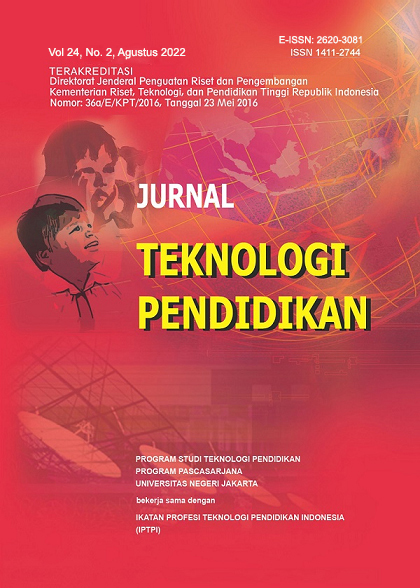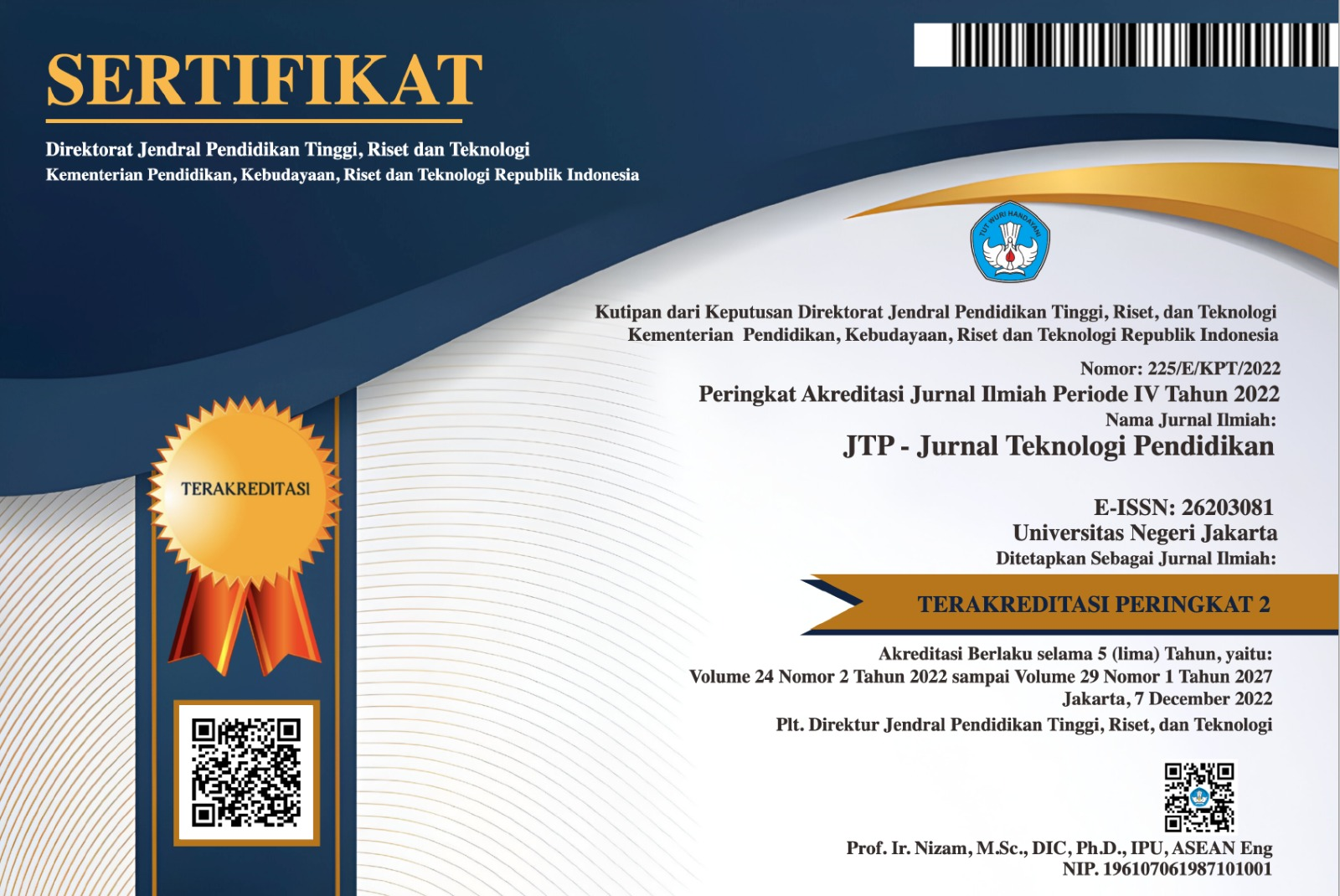Educational Media in Japanese Language E-Learning: Teacher Selection/Preparation and Perception
DOI:
https://doi.org/10.21009/jtp.v24i2.24220Keywords:
educational media, a purposive online survey, teaching materialAbstract
Educational Media is a determining factor in achieving the success of the learning process, especially in e-learning. E-learning is something new for teachers in Indonesia, especially Japanese high school and vocational high school teachers in Bali. There may be problems arising in the preparation and use of educational media. Therefore, it is important to know how the teacher determines the media in Japanese e-learning and teachers' perceptions of the use of these media. To obtain answers to these questions, a purposive online survey was conducted, followed by descriptive analysis. The survey was conducted on 117 Japanese high school and vocational high school teachers in Bali. The determination of the online learning platform is based on the results of discussions between related parties in education, especially students and teachers. The selection of educational media (teaching material) is tailored to the needs of delivering materials and the student conditions. Regarding teachers' perceptions of the use of media, there are differences in terms of the criteria for the gender of the teacher and the hours of experience of the teacher. Meanwhile, in the education level criteria, there is no difference in the perception of the teacher.
References
Akrim. (2018). Media Learning in Digital Era. Advances in Social Science, Education and Humanities Research, 231, 458–460. Atlantis Press. https://doi.org/10.2991/amca-18.2018.127
Al-Rahmi, W. M., & Zeki, A. M. (2017). A model of using social media for collaborative learning to enhance learners’ performance on learning. Journal of King Saud University – Computer and Information Sciences, 29, 526–535. https://doi.org/10.1016/j.jksuci.2016.09.002
Bayram, L. (2013). Enhancing an online distance education course with video. Procedia - Social and Behavioral Sciences, 83, 463–467. Elsevier Ltd. https://doi.org/10.1016/j.sbspro.2013.06.091
Demuyakor, J. (2020). Coronavirus (COVID-19) and Online Learning in Higher Institutions of Education: A Survey of the Perceptions of Ghanaian International Students in China. Online Journal of Communication and Media Technologies, 10(3), e202018. https://doi.org/10.29333/ojcmt/8286
Herliandry, L. D., Nurhasanah, N., Suban, M. E., & Kuswanto, H. (2020). Pembelajaran Pada Masa Pandemi Covid-19. JTP - Jurnal Teknologi Pendidikan, 22(1), 65–70. https://doi.org/10.21009/jtp.v22i1.15286
Lin, M.-H., Chen, H.-C., & Liu, K.-S. (2017). A Study of the Effects of Digital Learning on Learning Motivation and Learning Outcome. EURASIA Journal of Mathematics Science and Technology Education, 3553–3564. https://doi.org/10.12973/eurasia.2017.00744a
Mardani, D. M. S., Sadyana, I. W., & Adnyani, L. D. S. (2020). Learning Japanese Language Based on 2013 Curriculum at Elementary Schools in Bali. Advances in Social Science, Education and Humanities Research, 394, 246–251. Sanur, Bali: Atlantis Press. https://dx.doi.org/10.2991/assehr.k.200115.040
Marpanaji, E., Mahali, M. I., & Putra, R. A. S. (2018). Survey on How to Select and Develop Learning Media Conducted by Teacher Professional Education Participants. J. Phys.: Conf. Ser. 1140 012014. IOP Publishing. https://doi.org/10.1088/1742-6596/1140/1/012014
Mohammadi, N., Ghorbani, V., & Hamidi, F. (2011). Effects of e-learning on Language Learning. Procedia Computer Science, 3, 464–468. Istanbul, Turkey: Elsevier Ltd. https://doi.org/10.1016/j.procs.2010.12.078
Naz, A. A., & Akbar, R. A. (2008). Use of Media for Effective Instruction its Importance: Some Consideration. Journal of Elementary Education, 18(1–2), 35–40.
Omodara, O. D., & Adu, E. I. (2014). Relevance of Educational Media and Multimedia Technology for Effective Service Delivery in Teaching and Learning Processes. IOSR Journal of Research & Method in Education (IOSR-JRME), 4(2), 48–51.
Oroujlou, N. (2012). The importance of media in foreign language learning. Procedia-Social and Behavioral Sciences, 51. Antalya, Turkey: Elsevier Ltd. https://doi.org/10.1016/j.sbspro.2012.08.113
Pupuh, F., & Sobry, S. (2009). Strategi Belajar Mengajar – Strategi Mewujudkan Pembelajaran Bermakna Melalui Penanaman Konsep Umum dan Konsep Islami. Bandung: PT. Refika Aditama.
Rasiah, R. R. V. (2014). Transformative Higher Education Teaching and Learning: Using Social Media in a Team-Based Learning Environment. Procedia - Social and Behavioral Sciences, 123, 369–379. University Lakeside Campus, Selangor Darul Ehsan, Malaysia: Elsevier Ltd. https://doi.org/10.1016/j.sbspro.2014.01.1435
Rodzalan, S. A., & Saat, M. M. (2015). The Perception of Critical Thinking and Problem Solving Skill among Malaysian Undergraduate Students. Procedia - Social and Behavioral Sciences, 172, 725–732. https://doi.org/10.1016/j.sbspro.2015.01.425
Sangsawang, T. (2015). Instructional design framework for educational media. Procedia - Social and Behavioral Sciences, 176, 65–80. Chicago, IL, USA: Elsevier Ltd. https://doi.org/10.1016/j.sbspro.2015.01.445
Sudrajat, A. (2008). Pengertian, Fungsi, dan Jenis Media Pembelajaran. Retrieved from https://akhmadsudrajat.wordpress.com/2008/01/12/konsep-media-pembelajaran/
Suduc, A.-M., Bizoi, M., Gorghiu, G., & Gorghiu, L.-M. (2012). Digital images, video and web conferences in education: A case study. Procedia - Social and Behavioral Sciences, 46, 4102–4106. Barcelona, Spain: sevier Ltd. Se. https://doi.org/10.1016/j.sbspro.2012.06.207
Suh, H. (2011). Collaborative Learning Models and Support Technologies in the Future Classroom. International Journal for Educational Media and Technology, 5(1), 50–61.
Triacca, S. (2017). Teaching and Learning with Pictures The Use of Photography in Primary Schools. Proceedings 2017, 1, 952. Presented at the the International and Interdisciplinary Conference IMMAGINI? Image and Imagination between Representation, Communication, Education and Psychology, Brixen, Italy. https://doi.org/10.3390/proceedings1090952
Downloads
Published
How to Cite
Issue
Section
License
Jurnal Teknologi Pendidikan is an Open Access Journal. The authors who publish the manuscript in Jurnal Teknologi Pendidikan agree to the following terms.
Attribution-ShareAlike 4.0 International (CC BY-SA 4.0)
-
Attribution — You must give appropriate credit, provide a link to the license, and indicate if changes were made. You may do so in any reasonable manner, but not in any way that suggests the licensor endorses you or your use.
-
ShareAlike — If you remix, transform, or build upon the material, you must distribute your contributions under the same license as the original.
- No additional restrictions — You may not apply legal terms or technological measures that legally restrict others from doing anything the license permits.
Notices:
- You do not have to comply with the license for elements of the material in the public domain or where your use is permitted by an applicable exception or limitation.
- No warranties are given. The license may not give you all of the permissions necessary for your intended use. For example, other rights such as publicity, privacy, or moral rights may limit how you use the material.








